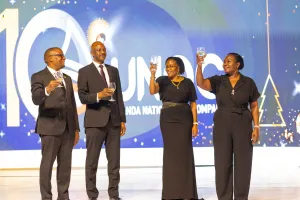

An aerial view of the dam (on the right, and the Tanzanian town across the border
The citizens of Burundi, Rwanda and Tanzania – three of the member countries of the Nile Basin Initiative (NBI), have started tapping electricity that is generated by the newly constructed Rusumo hydro-electric power station.
By the time of filing this article, the NELSAP team had signed certificates of completion with Rusumo Power Company Ltd, for two of the three installed turbines, with the third currently undergoing final tests ahead of full handover expected in April 2024.
Rusumo Power company was established by the three countries as a joint venture that will manage the dam when construction work ends.
Layout of the plant
Located behind the picturesque Rusumo falls – just adjacent to Rusumo bridge and border point between Rwanda and Tanzania, the 80 MegaWatt hydro-power station is the culmination of high levels of cooperation dating back over a period of about three decades.
The run-of-the river dam is located right across the Akagera river, near the border with Tanzania. The river’s furthest tributaries are located in Burundi.
Besides the dam, is a 703 meter long tunnel that was dug beneath the rock on the Tanzanian side. It delivers water at high speed that moves the turbines and the connected generators to produce power.
From the power house, the generated power is transmitted to the switchyard located on an elevated hill on Rwanda side where voltage is stepped up and distributed to three separate transmission lines that connect to each of the three countries’ power grids.
The dam was built in such a way that each country would have a dedicated turbine, switch and separate transmission line. In fact, at the switchyard, each country delivered its own switch gear.
Engineers at the Nile Equatorial Lakes Subsidiary Action Plan Coordinating Unit (NELSAP-CU) which is overseeing implementation of the project on behalf of the three partner countries, told The Sunrise that the project is currently at 99.9 percent completion rate, with handover expected to take place in March 2024.
“We are currently doing tests on the last of the three turbines with the hope that we can handover the project next month,” said Eng. Oduor Alyse, the Project Manager overseeing the entire project o behind of NELSAP.
A bit of background
Rusumo falls located on Akagera river, had long been earmarked as a high-value site with big potential for hydro-electric power production. Its location on the border separating Rwanda and Tanzania, largely contributed to hesitation among politicians from both countries and hence the delay in achieving its implementation.
Thanks to efforts by the Nile Basin Initiative (NBI) which nurtured the spirit of cooperation, as the best way in managing and utilising shared water resources, commitment was eventually realised.
This led to not only both countries accepting to jointly invest in the project, but also accepting that Burundi, which is the source of the bulk of the waters of Akagera river, joins in the project as an equal partner.
The demonstrated sense of political maturity underscores the high degree of appreciation among leaders and technocrats in the three countries, of the need for cooperation in the utilisation of shared water resources.
With a 99 percent completion rate that has been realised at the 80 Mega Watt dam, according to engineers at NELSAP-CU, the implementing agency for the project, the dam is already dispatching energy to the electricity grids of the three member countries.
The development represents a huge milestone achievement for cooperation over shared water resources, particularly, the Nile.
Eng. Sowedi Sewagudde, Assistant Commissioner in charge of Transboundary Cooperation observed that the realisation of Rusumo is testament to the need for countries to strengthen Cooperation, without which such transboundary water resources can not be achieved.
Besides the development of Rusumo dam the project has further put in place a power interconnection network that allows not only the three member countries to trade power, but also allows the these countries to tap into the wider East African Power pool.
As Eng. Jacob Manyoun Deng, the NELSAP power program officer, revealed, the power interconnection network would allow countries that don’t share a common border to trade power by signing wheeling agreements.














Henry Lutaaya
Leave a Comment
Your email address will not be published.